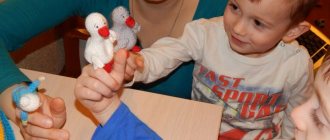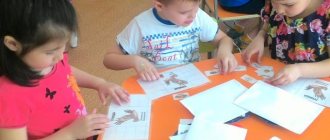What if the child answers “I don’t know”?
In fact, those who work using the TRIZ method are faced with a variety of situations, including childish stubbornness, reluctance to make contact, and getting involved in games using the TRIZ method. And we have already prepared recommendations for you on what to do in these cases [K. Nesyutina, 2014]. As a rule, such situations happen due to shortcomings on the part of adults. If desired, such situations are completely correctable, and over time, you can ensure that, upon hearing a question, the child begins to think about the answer, and not just remain silent or say “I don’t know.”
What to do to get your child to start thinking and reasoning:
- Never scold children for giving the wrong answer! Very often, “playing the silent game” is a consequence of the fact that the child has already said or done something wrong, received a bunch of comments, and is now simply afraid of making a mistake again.
- Reason with your child and don’t act like an examiner or a know-it-all. Children are acutely aware of falsehood, and if the child is already accustomed to the fact that you always know the correct answer and ask questions only for the purpose of testing, he may not want to be a test subject. Especially if, in case of an incorrect answer, he will also be scolded.
- Ask so-called “open” questions, for which there cannot initially be one single correct answer. This will make it easier for you to reason with your child, and the child will not be afraid to make mistakes. At the same time, he will understand that a different opinion is not necessarily wrong.
- Answer the questions your children ask you. Otherwise, children will quickly learn that they don’t have to answer or answer all “Whys” with “Because it ends in “y.” As a rule, children pick up such excuses from adults.
We wish that your children are healthy and happy, and that you always find a common language with them! We remind you that our program “TRIZ in practice: a creative approach at work and in life” and a screening test on the topic of the article are waiting for you:
We also recommend reading:
- Storytelling
- TRIZ fairy tales in pedagogy
- Charette procedure
- Creativity Development Digest
- Invention: a selection of useful materials
- TRIZ, RTV and TRTL in practice: dealing with the Soviet intellectual past
- TRIZ and design thinking in everyday life
- Good books for self-education
- TRIZ classes for children: raising geniuses and simply happy people!
- Secrets of inventors: a selection of useful materials
- A selection of useful materials about creativity and creativity development
Key words:1TRIZ
Why is the TRIZ methodology needed in kindergarten?
We all come from childhood, and the foundations of a person’s future life are laid precisely in preschool age. At this time, the little person learns to walk and talk, read and write, listen and understand, communicate and express emotions, and, of course, think.
Today, creative thinking is needed in almost any field of activity: law and software development, medicine and the construction of country cottages, pedagogy and even the installation of telecommunication networks, because communication means penetrate where nothing is suitable for their use.
How work with children in kindergarten is structured largely determines how creative thinking will be developed in children. And, therefore, how well they will study, how well they will choose a profession and how well they will be able to fit into the modern world. The objectives of the TRIZ methodology are precisely to teach a creative approach, and therefore are ideally suited for working with preschoolers.
Children are not yet constrained by perception patterns, they are inquisitive and spontaneous, they are just learning about this life. Therefore, nothing prevents them from imagining their imaginary world and deciding for themselves how they want to see it. Ideally, children should not only not be disturbed, but also indulge in every possible way their desire for creativity and learning everything new. The introduction of the TRIZ methodology in a preschool educational institution (preschool educational institution) contributes to the creative process to the fullest.
Let us note that creativity is not some separate process isolated from everything else. Creativity is directly related to the development of analytical thinking, observation, attentiveness, imagination, speech, and the acquisition of new sensorimotor skills. As a result, the ability to think creatively contributes to the formation of a multifaceted personality with a broad outlook and the ability to practically solve emerging problems.
Objectives of the TRIZ methodology:
- Development of creative perception and thinking.
- Development of the qualities of a creative personality.
- Formation of vocabulary.
- Development of coherent speech and the ability to express thoughts.
- Pronunciation correction.
- Formation of perception of numbers and mathematical concepts.
- Teaching constructive activities.
- Instilling socialization, interaction and teamwork skills.
Thus, the TRIZ methodology contributes not only to creativity itself. The TRIZ technique is no less useful in developing coherent speech, replenishing vocabulary, acquiring skills in operating numbers and mathematical concepts, and much more. It is probably easier to find what is not included in the tasks of the TRIZ methodology.
Therefore, the TRIZ methodology in kindergarten is needed, on the one hand, to develop flexibility and systematic thinking, and on the other hand, to stimulate search activity and the ability to find answers to non-standard questions. Using the TRIZ methodology, you can significantly activate a child’s creative potential, his mental activity and imagination, and raise a child into a real inventor and generator of new ideas.
And one more important point. A kindergarten, a group in a kindergarten, is a small group, but a team. And sometimes it’s not a small, but a fairly large children’s group. Group classes using the TRIZ method teach children cooperation, interaction, the ability to help a friend and find a way out of a difficult situation, as well as rejoice at their own and others’ successes when the problem is successfully solved.
The results will not take long to arrive. Parents and educators will soon see that the child’s drawings have become more diverse, artistic subjects are more complex, speech is more literate, and now the child assembles structures from Lego not only from the proposed pictures, but also by inventing his own figures.
In general, TRIZ is a useful technique for children in all respects. All that remains is to figure out how to apply such a complex technique as TRIZ for such young children as preschoolers.
What is TRIZ?
First, let's say a few words about what TRIZ is. The original idea of TRIZ is that different problems can often be solved using the same methods. The theory is based on several dozen ready-made techniques and solution templates, from which you need to select the most suitable ones for a specific task.
Initially, the posed problem is reduced to a certain general form, then a suitable technique is sought to solve it, and then the solution found is applied to the initially posed problem. At first, the theory was used to solve technical problems, but later it became clear that TRIZ could be applied to life and to solve a wide range of problems.
The very first version of the theory of solving inventive problems was developed by
Genrikh Saulovich Altshuller (1926-1998), known to science fiction fans under the pseudonym Genrikh Altov. Yes, he is not only an inventor, but also a talented writer, and his “Legends of Star Captains” and other works are loved by many generations of readers [G. Altov, 2015]. By the way, Heinrich Altshuller wrote a lot for children. Is this why the theory he invented for solving inventive problems is applicable even to kindergartens?
Heinrich Altshuller began developing the principles and methodology of TRIZ in the post-war years, then continued to work on the theory in collaboration with the inventor Rafael Borisovich Shapiro (1926-1993). By the way, Shapiro was also a writer and signed his works with the pseudonym Rafail Bakhtamov. It is significant that the very first publication devoted to TRIZ touched primarily on issues of the psychology of invention and was called “On the Psychology of Inventive Creativity” [G. Altshuller, R. Shapiro, 1956].
In the same article, an attempt was made to systematize the creative process, breaking it down into stages:
- Analytical stage – selection and definition of the fundamentals of the problem, identification of the main contradiction and its causes.
- The operational stage is the study of typical solutions in nature and technology, and the subsequent search for new methods within the system and beyond.
- The synthetic stage is the introduction of functionally determined changes to the system and methods of its use, checking the applicability of the principle to solving other problems.
The concepts, methods and solution schemes were presented in more detail in the book “Introduction to TRIZ”, which was subsequently republished many times. Basic concepts and approaches" [G. Altshuller, 2011]. Thus, the author of the theory believes that the first step to invention is the correct formulation of the situation so as to immediately exclude from consideration not very effective and not very promising solutions.
Next, you need to set the task in the format of “remove unnecessary quality without losing the functionality of the system” or “add the desired quality in addition to the existing ones.” This formulation of the problem allows us to answer a number of extremely important questions for subsequent work :
- What parts does the system have and how do they interact?
- Which parts and interactions are beneficial, which are harmful, and which are neutral?
- What can be changed without losing functionality, and what cannot?
- What will lead to improvement of system functions and what will lead to deterioration?
Then you need to identify contradictions on the way to solving all these issues and eliminate them. For example, to increase the strength of a structure without increasing the mass of the structure. Actually, after all this has been done, there is literally a step left before invention. The algorithm for solving inventive problems (abbreviated as ARIZ) developed by Heinrich Altshuller includes several dozen steps. The number of steps varies depending on the version of the algorithm.
How can all of the above be applied in kindergarten, when most children have just begun to memorize letters and numbers? Let's find out!





